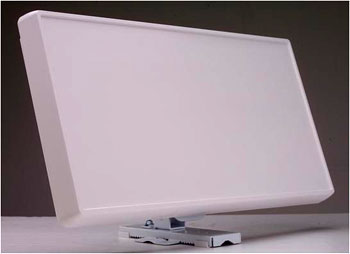Satellite dishes aren't just for your television. These devices are used all over the world for radio communications and even space exploration. There are several different types of satellite dishes, each of which uses a different:
Prime Feed Focus Dish

The prime feed focus dish has the classic antenna shape most people associate with satellite dishes. This antenna is positioned in the center of a parabolic satellite dish. This dish is often used for television and radio communications. The main advantage of this design is the strong reception the antenna is able to receive.
Offset Antenna Dish

The offset antenna is similar to the prime feed antenna except for the fact the antenna is off-centered. The antenna is usually set at a 21-degree angle and focuses the reception toward the bottom of the antenna. This design has proven to be more efficient than dishes with a centered antenna, but offset antennas are more costly to produce.
Flat Antenna

Flat antennas are the smallest of the satellite dishes and have one noticeably unique feature: They do not have a curve. As their name indicates, flat antennas have a completely flat surface and use an internal antenna that is not visible. Flat antennas tend to be compact and square in shape, making them perfect if you need to squeeze a dish into a small area. They do have a weak reception compared with other antenna types and must have a unobstructed path to get a strong signal.
Multi-Beam Antenna

The multi-beam antenna uses a long-distance narrow-beam directional element. The unique shape of the dish allows the multi-beam antenna to receive and transmit information from multiple directions. This means the antenna does not need to be pointed in any one direction like most others. This reduces the need for multiple satellite dishes and makes the mutli-beam antenna one of the most efficient antennas available
Prime Feed Focus Dish

The prime feed focus dish has the classic antenna shape most people associate with satellite dishes. This antenna is positioned in the center of a parabolic satellite dish. This dish is often used for television and radio communications. The main advantage of this design is the strong reception the antenna is able to receive.
Offset Antenna Dish

The offset antenna is similar to the prime feed antenna except for the fact the antenna is off-centered. The antenna is usually set at a 21-degree angle and focuses the reception toward the bottom of the antenna. This design has proven to be more efficient than dishes with a centered antenna, but offset antennas are more costly to produce.
Flat Antenna

Flat antennas are the smallest of the satellite dishes and have one noticeably unique feature: They do not have a curve. As their name indicates, flat antennas have a completely flat surface and use an internal antenna that is not visible. Flat antennas tend to be compact and square in shape, making them perfect if you need to squeeze a dish into a small area. They do have a weak reception compared with other antenna types and must have a unobstructed path to get a strong signal.
Multi-Beam Antenna

The multi-beam antenna uses a long-distance narrow-beam directional element. The unique shape of the dish allows the multi-beam antenna to receive and transmit information from multiple directions. This means the antenna does not need to be pointed in any one direction like most others. This reduces the need for multiple satellite dishes and makes the mutli-beam antenna one of the most efficient antennas available
